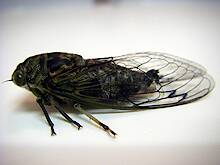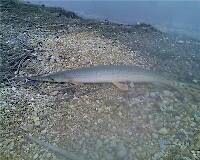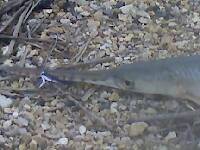
Blue-winged Olives
Baetis
Tiny Baetis mayflies are perhaps the most commonly encountered and imitated by anglers on all American trout streams due to their great abundance, widespread distribution, and trout-friendly emergence habits.
Featured on the forum

Some characteristics from the microscope images for the tentative species id: The postero-lateral projections are found only on segment 9, not segment 8. Based on the key in Jacobus et al. (2014), it appears to key to Neoleptophlebia adoptiva or Neoleptophlebia heteronea, same as this specimen with pretty different abdominal markings. However, distinguishing between those calls for comparing the lengths of the second and third segment of the labial palp, and this one (like the other one) only seems to have two segments. So I'm stuck on them both. It's likely that the fact that they're immature nymphs stymies identification in some important way.

Troutnut is a project started in 2003 by salmonid ecologist Jason "Troutnut" Neuswanger to help anglers and
fly tyers unabashedly embrace the entomological side of the sport. Learn more about Troutnut or
support the project for an enhanced experience here.
Falsifly on Aug 17, 2009August 17th, 2009, 9:59 am EDT
Many years ago, while fishing the gin clear water in the rarified air of the much higher ups, I witnessed a rise to my dry that has forever been indelibly recorded and stored in the My Videos folder of my psyche. What a gift it is to have vivid total recall, off the water. I often wonder if others, like me, spend the restless and sleepless hours surrounded in absolute darkness recalling the myriad of memorable trout fishing memories in a way that brings them back to life.
I had just finished nymphing a section of water between shore and the bank of a small island, working downstream. At the downstream apex of the island I set course in the opposite direction, again fishing the deeper cut between shore and island bank. The morning trout had, up until now, remained not only tight mouthed but invisible. Always mindful to remain vigilant I caught the fleeting glimpse of a rise, along shore opposite the islands upstream tip. Abandoning my fruitless attempt at dousing dead weight I made a stealthy Bee-Line to a point about forty feet below my center of concentration. It was from here that I first noticed a very sparse and well staggered number of duns slowly skirting the bank. Closing in I spotted the fish holding tight to the bank in about two feet of water, refusing to take anything unless it pasted directly over its head. My choice of dries was limited; the best match I could come up with was in size only. I looped in my longest leader which was a twelve foot tapered to 5x, and bound in a #16 Adams. The first cast, although close, didn’t even produce a fin tingle, but the second cast produced an epic slow motion video that has been stuck on replay ever since. I will describe the setting first and then reveal, as best I can, what was set into motion.
It was early mid morning, not a cloud in the sky, the lighting was perfect. I was about twenty feet below the fish, a Brown of about eighteen inches in about eighteen inches of water. The water was crystal clear over white gravel, and the fish was hugging the bank in an almost non-existent current. If this fish had eyelashes I could’ve counted them. The cast placed the fly as far ahead as I was able without lining the fish, and the current set the motion to dead slow. Immediately I knew this was the cast. As the fly approached the fish, on a path placing it directly over its head, the fish remained motionless, five feet, four feet, three feet, and nary a flicker of a fin. I had given up hope on this drift when, at about two feet, a most incredible event took place. The head of the fish began to rise in perfect harmony with the speed and distance of the fly. But the fish wasn’t rising in a horizontal manner; it was rising in vertical stature, as if its tail was a pair of feet firmly set on the bottom. This continued until the fish was standing perfectly vertical, still facing upstream with the fly on the tip of its nose. I was mesmerized watching this unfold, but the fish had not taken. It was then that I watch in total awe. In a perfectly executed vertical maneuver the fish performed a one hundred and eighty degree pirouette, now facing downstream the fly departing from the tip of its nose; it opened its mouth and sucked the fly in from behind.
I had just finished nymphing a section of water between shore and the bank of a small island, working downstream. At the downstream apex of the island I set course in the opposite direction, again fishing the deeper cut between shore and island bank. The morning trout had, up until now, remained not only tight mouthed but invisible. Always mindful to remain vigilant I caught the fleeting glimpse of a rise, along shore opposite the islands upstream tip. Abandoning my fruitless attempt at dousing dead weight I made a stealthy Bee-Line to a point about forty feet below my center of concentration. It was from here that I first noticed a very sparse and well staggered number of duns slowly skirting the bank. Closing in I spotted the fish holding tight to the bank in about two feet of water, refusing to take anything unless it pasted directly over its head. My choice of dries was limited; the best match I could come up with was in size only. I looped in my longest leader which was a twelve foot tapered to 5x, and bound in a #16 Adams. The first cast, although close, didn’t even produce a fin tingle, but the second cast produced an epic slow motion video that has been stuck on replay ever since. I will describe the setting first and then reveal, as best I can, what was set into motion.
It was early mid morning, not a cloud in the sky, the lighting was perfect. I was about twenty feet below the fish, a Brown of about eighteen inches in about eighteen inches of water. The water was crystal clear over white gravel, and the fish was hugging the bank in an almost non-existent current. If this fish had eyelashes I could’ve counted them. The cast placed the fly as far ahead as I was able without lining the fish, and the current set the motion to dead slow. Immediately I knew this was the cast. As the fly approached the fish, on a path placing it directly over its head, the fish remained motionless, five feet, four feet, three feet, and nary a flicker of a fin. I had given up hope on this drift when, at about two feet, a most incredible event took place. The head of the fish began to rise in perfect harmony with the speed and distance of the fly. But the fish wasn’t rising in a horizontal manner; it was rising in vertical stature, as if its tail was a pair of feet firmly set on the bottom. This continued until the fish was standing perfectly vertical, still facing upstream with the fly on the tip of its nose. I was mesmerized watching this unfold, but the fish had not taken. It was then that I watch in total awe. In a perfectly executed vertical maneuver the fish performed a one hundred and eighty degree pirouette, now facing downstream the fly departing from the tip of its nose; it opened its mouth and sucked the fly in from behind.
Falsifly
When asked what I just caught that monster on I showed him. He put on his magnifiers and said, "I can't believe they can see that."
When asked what I just caught that monster on I showed him. He put on his magnifiers and said, "I can't believe they can see that."
GONZO on Aug 17, 2009August 17th, 2009, 10:24 am EDT
Nice description, Falsifly. I've seen that same vertical inspection posture, sometimes resulting in a take (with or without a pirouette) and sometimes resulting in a sullen sinking and a return to the original position. One of my most vivid memories of this was a fish on Big Spring that stood on its "tiptoes" and tracked my fly, about an inch from its nose, for about 12 feet before sucking it in. I've seen many other lengthy inspections like that, but they usually ended in refusal.
DayTripper on Aug 17, 2009August 17th, 2009, 1:52 pm EDT
Had the same thing happen on NY's Ausable a couple weeks ago. That fish was messing with me big time.
Quick Reply
Related Discussions
Topic
Replies
Last Reply
4
May 19, 2009
by Willmilne
by Willmilne
7
May 29, 2012
by Possumpoint
by Possumpoint





